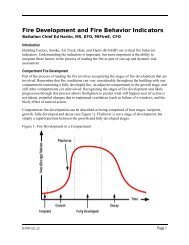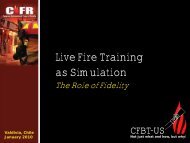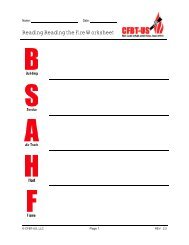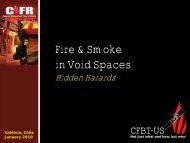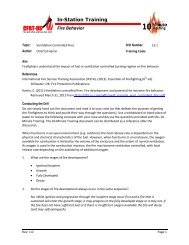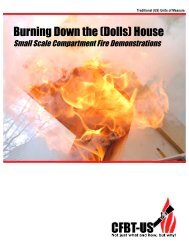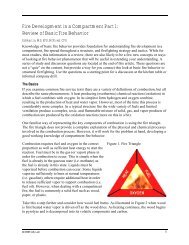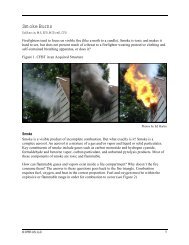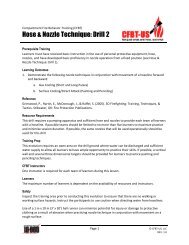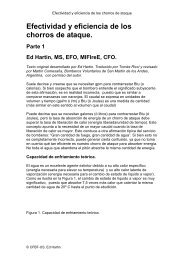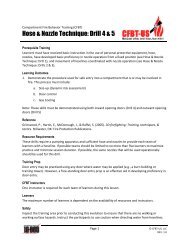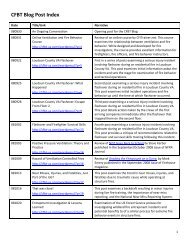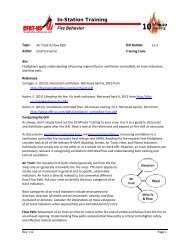CFBT INSTRUCTOR COURSE INFORMATION SHEET ... - CFBT-US!
CFBT INSTRUCTOR COURSE INFORMATION SHEET ... - CFBT-US!
CFBT INSTRUCTOR COURSE INFORMATION SHEET ... - CFBT-US!
Create successful ePaper yourself
Turn your PDF publications into a flip-book with our unique Google optimized e-Paper software.
<strong>CFBT</strong> <strong>INSTRUCTOR</strong> - <strong>COURSE</strong> <strong>INFORMATION</strong> <strong>SHEET</strong><br />
• Identify common errors that impact on safety during <strong>CFBT</strong>.<br />
• Explain how to maximize situational awareness on the part of all participants during <strong>CFBT</strong>.<br />
• Describe the potential impact of CRM on your practice as a <strong>CFBT</strong> Instructor and on your<br />
organization.<br />
Fire Attack 1 (Live Fire)<br />
Participants understand how to conduct the Fire Attack 1evolution. Developing competence in conducting<br />
this evolution will require coached practice.<br />
• Understand the <strong>CFBT</strong>-<strong>US</strong> standard operating guidelines applicable to conducting Fire Attack 1.<br />
• Identify the potential problems that might occur while conducting Fire Attack 1 and the<br />
appropriate methods for resolving these problems.<br />
• Identify the procedure used to inspect the demo/attack cell prior to use.<br />
• Recognize the required elements of a pre-training safety and instructional briefing and walk<br />
through of the prop used for live fire training.<br />
• Describe the participant learning outcomes for Fire Attack 1.<br />
• Explain how the instructor maintains appropriate fire conditions for the duration of Fire Attack 1.<br />
• Demonstrate proficiency in gas and surface cooling techniques under live fire conditions.<br />
• Describe the advantages and disadvantages of verbal and non-verbal instructional styles for<br />
conducting Fire Attack 1.<br />
• Explain the post-training debriefing process with particular emphasis on the use of questions to<br />
enhance participant learning.<br />
Fire Attack 2 (Live Fire)<br />
Participants understand how to conduct the Fire Attack 2 evolution. Developing competence in<br />
conducting this evolution will require coached practice.<br />
• Understand the <strong>CFBT</strong>-<strong>US</strong> standard operating guidelines applicable to conducting Fire Attack 2.<br />
• Identify the potential problems that might occur while conducting Fire Attack 2 and the<br />
appropriate methods for resolving these problems.<br />
• Identify the procedure used to inspect the demo/attack cell prior to use.<br />
• Recognize the required elements of a pre-training safety and instructional briefing and walk<br />
through of the prop used for live fire training.<br />
• Describe the participant learning outcomes for Fire Attack 1.<br />
• Explain how the instructor maintains appropriate fire conditions for the duration of Fire Attack 2.<br />
• Demonstrate proficiency in gas cooling while advancing and retreating and surface cooling<br />
techniques under live fire conditions.<br />
• Describe the advantages and disadvantages of verbal and non-verbal instructional styles for<br />
conducting Fire Attack 2.<br />
© <strong>CFBT</strong>-<strong>US</strong>,LLC Page 8 REV: 2.0<br />
www.cfbt-us.com 10/12/08




